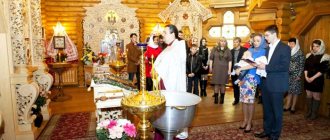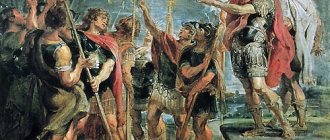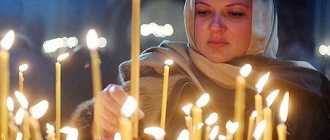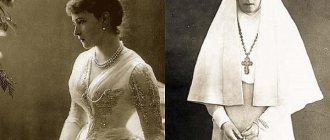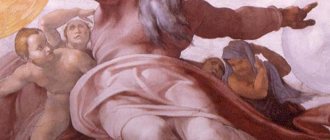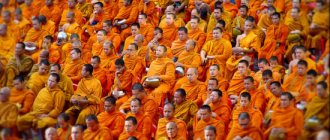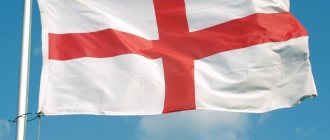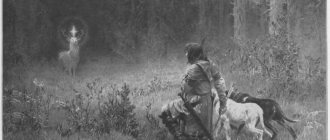The image of the Almighty Father is considered unique and has been known since ancient times. More often on icons, Hosts appears as a gray-haired old man on a throne, with great wisdom and calmness visible in His eyes. The face of the Lord the Father in the images is placed in a symbolic triangle, which tells Orthodox believers about the presence of the Holy Trinity, originating from the Almighty and One God himself.
In front of the icon of Hosts, they ask for the remission of vicious sins, for giving strength to perform beneficial deeds that cleanse the heart and environment.
Why you can't portray God the Father
Such champions of the veneration of icons as St. John of Damascus and St. Theodore the Studite argued that the icon of God cannot be painted, since we do not see Him, unlike God the Son - Jesus Christ, Who had two hypostases - human and divine, and the saints who were people. As John says (1:18), “No one has ever seen God.”
The Holy Fathers rejected the icons of the Lord, since they are anthropomorphic, that is, created in the image and likeness of man, the image of God the Father. Theologians define God the Father as the first, initial and causal hypostasis of the Holy Trinity.
Historical reference
Hosts - one of the names of the Most High God, mentioned in the Holy Scriptures, is of Hebrew origin and translated means “army” (that is, the Lord who created the army).
God of Hosts. Painting by V.M. Vasnetsova
By the armies of the Creator we mean:
- defenders of Israeli lands;
- heavenly servants of God;
- the hosts of saints surrounding Him;
- stars and other similar space objects.
The phrase “Lord of Hosts” took root in the Old Testament period. As a cult name, it was used in the sanctuaries of the Hebrew city of Shiloh and was associated with the Christian Ark of the Covenant.
The doctrine of the trinity of the Holy Trinity
The Trinity of the Holy Trinity is the main Christian dogma. She is one in three persons: God the Father, God the Son (Jesus Christ) and God the Holy Spirit (depicted as a Dove), which at the same time are not fused with each other, and are inseparable manifestations of one of the essences of the Lord. This is the so-called Old Testament Trinity, the best embodiment of which in Russian icon painting was “The Trinity” by Andrei Rublev.
The famous icon of Andrei Rublev “Trinity” shows the symbolic embodiment of the Trinity in accordance with the canon. However, the “Fatherland” icon, which is often called the “New Testament Trinity,” depicts Her in a completely different way, although the three faces of the Lord should symbolize His Trinity.
Here God the Father appears in the form of a majestic old man with a gray beard, sitting on a throne; God the Son is in the form of Christ Emmanuel (Emmanuel is the designation of Jesus the youth), and on His chest, in the sphere, is a Dove, symbolizing God the Holy Spirit.
The icon “Fatherland” is of very ancient origin: the first one that has come down to us dates back to the beginning of the 11th century
It was widespread and, despite the negative attitude of the church, it can be seen in the iconostasis of many churches. As a rule, it is placed on the iconostasis in the upper rank of the forefathers, so that it seems to overshadow the entire space of the temple.
The icon “God the Father of Hosts” is extremely rare. From a formal point of view, this is like an image of the New Testament Trinity, since the medallions on the chest of the Lord also depict the two other hypostases of the Trinity (God the Son and God the Holy Spirit), but the main attention is focused on the Face of God the Father.
To the sky
Ipatiev Monastery
The Ipatiev Monastery is the pearl of Kostroma. It is connected in a special way with Russian history. The Godunovs were the patrons of the monastery; their family tomb was located here. From here began a new era of Russian statehood: on March 13, 1613, the embassy of the Zemsky Sobor arrived at the monastery, where young Mikhail Romanov lived with his mother nun Martha in the fall of 1612, who elected Mikhail as king, and the next day, March 14, at the Trinity Cathedral At the monastery, a solemn rite of calling to the kingdom was performed, which put an end to the Time of Troubles. Trinity Cathedral is the main church of the monastery. The cathedral's frescoes are a wonderful example of fresco painting from the second half of the 17th century - unique in their execution, composition and variety of subjects.
We talk with Lyudmila Burdina, the tour guide of the Ipatiev Monastery, about the paintings of this temple, the features of Orthodox art and its differences from Western European art, about what and how this art can teach our contemporaries, especially young people.
Tragedy or transformation of the world?
Last Judgment. Trinity Cathedral of the Ipatiev Monastery. Photo: pavel-otdelnov.livejournal.com
– The monumental fresco “The Last Judgment” on the western wall of the Trinity Cathedral of the Ipatiev Monastery attracts attention immediately as soon as you enter the temple. And I noticed that all tourists are told about it in particular detail. Why is there such interest in this particular fresco?
– Firstly, this is one of the oldest frescoes of the cathedral – 1654. And besides, we all face the Judgment of God. This affects every person most directly.
And the fresco is interesting not only for its size and detailed composition, but also for the importance and significance of the topic raised. After all, it speaks about the fate of the entire human race, and about the posthumous fate of an individual person before the Second Coming of the Savior and the Last Judgment. The images of the fresco allow us to clearly imagine the moment of the soul’s meeting with God and to prepare for it.
– The Last Judgment is the theme of many works of art. And the first thing that comes to mind is Michelangelo’s famous fresco in the Sistine Chapel. It was painted a century earlier than the frescoes of the Ipatiev Monastery, in the middle of the 16th century. Tell me, is it appropriate to compare these two frescoes?
Last Judgment. Michelangelo's fresco in the Sistine Chapel
– Michelangelo embodies the theme of the Last Judgment as a tragedy on a cosmic scale. The composition is perceived as a catastrophe, the collapse of the world.
Yes, on the fresco of the Sistine Chapel the figures are executed with an amazing knowledge of the proportions of the human body and the laws of harmony: you can study anatomy from them. Each person has its own unique personality and psychological characteristics. But at the same time, the fresco is made in a distinctly naturalistic style, full of emotions and passions. In it the Heavenly is transferred to the earthly plane, unregenerated materiality is transferred to the sphere of Heaven; the earthly and sensual are replaced by the spiritual and eternal.
And look at how the Mother of God is depicted in Michelangelo’s fresco: in Her pose there is rejection, complete rejection of the horror and suffering of sinners thrown into the abysses of hell.
In Orthodox art, the image of the Last Judgment (like any Orthodox icon) is a prayer. There is no strain, broken poses, horror, or faces distorted by suffering.
The main compositional lines of our fresco “The Last Judgment”, painted by Vasily Ilyin Zapokrovsky, are an oval, a circle: the lines are smooth, harmonious. The compositional lines of the main part of the fresco are directed towards Heaven, towards God. Yes, here you will see the “serpent of ordeals”, and the “merciful fornicator” hanging between heaven and hell, and the falling wave of sinners driven into fiery Gehenna. But the main idea here is the overcoming of sin, death, hell, the transformation of the world, the final triumph of God’s truth and love.
Last Judgment. Fragment. Trinity Cathedral of the Ipatiev Monastery. Photo: pavel-otdelnov.livejournal.com
The Lord sits on the Throne of Glory. Before him in prayer are the Queen of Heaven, John the Baptist, at the feet of the Savior the Sign of the Son of Man - the Cross on which He sacrificed Himself for the world. Adam and Eve stand before the cross in prayer. They love us all - we are all their children. Next is the Prepared Throne with the open Book of Life: the names of the righteous are inscribed in it. It’s scary if your name is crossed out from the Book of Life. But we ourselves cross out our name from this Book – through our dislike and untruth.
In Michelangelo, the righteous surround Christ the Savior. There is extreme tension and strain in their poses and facial expressions. In our fresco, the apostles are seated on thrones, along with them are the Angels of God, above is the feast of the righteous in the Kingdom of God.
The main idea of Michelangelo's "Last Judgment" is the horror of the inevitability of punishment and the endless torment of sinners, the fear of the formidable Judge. However, fear of punishment alone is difficult to change a person.
In the fresco of the Trinity Cathedral there is a call to repentance and faith in the possibility of salvation. The Lord did everything to make this happen: He took our sins upon Himself and washed them with His blood. However, our salvation is impossible without our participation. We are co-workers with God in this.
The truth about ourselves
Last Judgment. Fragment. Sinner at Judgment: the scale of good deeds outweighs the scale of evil. Trinity Cathedral of the Ipatiev Monastery. Photo: pavel-otdelnov.livejournal.com
– How did our ancestors perceive the fresco “The Last Judgment”? How clear were its plots to them?
– The middle of the 17th century in the history of Russia was a turbulent time. The year 1654, when the fresco was painted, marks the beginning of the reforms of Patriarch Nikon. This is a time of great confusion, confusion in the minds and rebellion of the “zealots of ancient piety.” At that time, the Russian people perceived with particular acuteness the teaching about the Judgment of God, about the final triumph of God's truth and love.
But, strange as it may sound, the fresco “The Last Judgment” is a surprisingly light subject.
– Please explain why the Last Judgment is a bright subject.
– This is definitely a bright story. Yes, sinners experience all kinds of torments; yes, human souls need to overcome ordeals... There is a struggle between good and evil, and this struggle already begins here, in our earthly life, and there it comes to an end.
What does the fresco say? That everything is directed towards God. “I am Alpha and Omega, the Beginning and the End” (Rev. 1:8), says the Savior. And the meaning of this fresco is overcoming sin, overcoming death, overcoming evil and ultimately victory over evil - over death.
Last Judgment. Fragment. Resurrection of the dead. Trinity Cathedral of the Ipatiev Monastery. Photo: pavel-otdelnov.livejournal.com
Already here, in this life, towards its end, we are determined in our choice: either you finally choose God and enter heaven, or, without overcoming sin - this serpent, you end up in hell.
The fresco speaks of the resurrection of the dead, that righteous people will enter the abode of the Heavenly Father, that the final triumph of God's truth and love will come. This is exactly how the fresco “The Last Judgment” should be understood.
We do not know how much time will pass before the Last Judgment, which will be beneficial for the righteous and terrible for sinners. But while we have the opportunity to look around us and understand ourselves, we must decide which side each of us will stand on. And we don’t need to be deceived and think that someone will put us somewhere. We ourselves will run away in shame from the Face of God, as Adam did when he hid in the bushes, hearing the voice of God calling to him: “Adam, where are you?”
You need to answer yourself: do I fulfill the commandments of the Lord, do I love my neighbor, do I help those who need my help, or do I drive them away from myself so that they don’t bother me?
In eternity the whole truth about ourselves is revealed
The defining principle of the Last Judgment is the real compassion we show to our neighbor. During the Second Coming, we will not be asked how strictly we fasted, how many vigils we performed, how many bows we made. They will ask us: did we feed the hungry? Have you given drink to the thirsty? did they invite the stranger into their home, did they clothe the naked, did they visit the sick and those in prison? (cf. Matthew 25: 34–46). This is what they will ask us about. In eternity the whole truth about ourselves is revealed. Therefore, the last Judgment will be terrible precisely because this truth, which perhaps we often hide from those around us and most of all from ourselves, will be presented to us in all its ugliness.
Following the canon
Trinity Cathedral of the Ipatiev Monastery. Photo: pavel-otdelnov.livejournal.com
– Is there a “zest” to the fresco of the Ipatiev Monastery, some unique detail that is not present in the images of the Last Judgment in other famous Russian churches?
– The Ipatiev fresco was made within the framework of the canon. Our art is interesting not because of any innovations, but because of its fidelity to the canon. The foundations of iconography were formed in Byzantium. This is the embodiment in a visible image of the dogmatic teaching of the Church. And the more committed an artist is to the canon, the more valuable his art is.
– Can we say that it is precisely this – adherence to the canon – that distinguishes Orthodox church art from Western European art?
- Yes. In addition, the development of art in the Christian West and in the Christian East took different paths.
For the first time, a fundamental instruction concerning the nature of the sacred image was formulated by the Fifth-Sixth Council of Trulla in 691-692. Rule 82 of the Council reveals the content of the sacred image as the Church understands it. This rule concerns the image of the Lord Jesus Christ. It instructs us to represent Christ in human form. In the first centuries, they often resorted to symbolic images of the Lord in the form of a fish and a lamb. Just like the fish, the lamb meant not only the Savior Himself, but also a Christian in general. The Fathers of the Council speak of ancient symbols as a stage that the Church has already passed through. The Council orders that the symbols of the Old Testament and the first centuries of Christianity be replaced by direct images, because the image contained in these symbols became reality in the Incarnation.
Lamb of God. Stained glass window of the Catholic Church of All Saints. Missouri, USA
Following the statement of the need for a direct image, the next part of the 82nd rule gives a dogmatic justification for this image, and this is precisely the main meaning of this rule. This first conciliar expression of the Christological basis of the icon was subsequently widely used and refined by icon defenders during the period of iconoclasm. The church image represents to us the human face of God incarnate, the historical face of Jesus Christ.
– But the icon of Christ should show that we are talking about God incarnate...
- Undoubtedly, the image should remind not only of the earthly life of the Savior, His suffering and death, it should also point to His glory, “the height of God the Word.” The very manner in which the Son of Man is depicted should reflect His Divine glory. The teaching of the Church is expressed not only in the plot, but also in the way that plot is conveyed. In the field of her art, the Church develops an artistic language corresponding to her experience and her knowledge of Divine Revelation. The purpose of church art is to accurately convey a specific historical image and in it to reveal spiritual and prophetic reality.
Canon 82 of the Trullo Council marks the beginning of the iconographic canon
The 82nd canon of the Trullo Council lays the foundation for what we call the iconographic canon, that is, a well-known criterion for the liturgical nature of an image, just as in the field of verbal canon the liturgical nature of a particular text is determined.
– What is the essence of the iconographic canon? Why is it so important to follow it?
– The iconographic canon is a well-known principle that allows us to judge whether a given image is an icon or not. He establishes the correspondence of the icon with the Holy Scriptures and determines what this correspondence consists of, that is, the authenticity of the transmission of Divine Revelation in historical reality in a way that we call symbolic realism.
The Trullo Council marked the end of the dogmatic struggle of the Church for the correct confession of two natures - Divine and human - in the Person of Jesus Christ. The Acts of the Fifth-Sixth Council were sent to Rome. However, dad refused to sign them. He declared the resolutions of the Council invalid. Thus, the Roman Church remained aloof from the formulation of the Church's teaching on the Christological basis of the sacred image.
Western sacred art to this day remains faithful to some purely symbolic images (notably the Savior as a lamb) as well as naturalistic images. In Orthodox art, symbol and allegory were relegated to the background: symbolic and allegorical images remained in decorative church art, for example, in the carving of iconostases.
Can we portray God the Father?
New Testament Trinity. Trinity Cathedral of the Ipatiev Monastery
– You said that the painting of the Trinity Cathedral is canonical. However, in the skufia of the central dome there is an image of the New Testament Trinity.
– Yes, this is one of the images that the clerk Ivan Viskovaty opposed back in the 16th century. He objected to the depiction of the Lord of Hosts as an old man. No one has ever seen God. God is visible and depictable only in incarnation. In the image of God the Father, Viskovaty saw an attempt to depict the indescribable being of God. For Viskovaty, the guiding principle in judging icon painting was the basic provisions of the Orthodox faith. Viskovaty was jealous of the truth, that is, of iconographic realism.
– Why do such images appear?
The rules of the councils prohibit depicting God the Father as an old man.
– God the Father – the first Hypostasis of the Holy Trinity – cannot be depicted at all. And the rules of Orthodox councils prohibit depicting God the Father in the form of an old man, as well as the Holy Spirit in the form of a dove (except for the icon of the Epiphany). In the words of Saint John the Theologian: “No one has ever seen God; The only begotten Son, who is in the bosom of the Father, He has revealed” (John 1:18), therefore the image (in Greek - icon) of God the Father is the Son of God Jesus Christ. In Orthodoxy, the Church Fathers associated this image with the theme of the incarnation of the eternal Son of God and the atoning sacrifice, as well as with the image of the coming Judge of the Second Coming.
Archbishop Andrew of Caesarea in his Commentary on the Revelation of John the Theologian says: “Sacrificed for us in these last times, He is, however, ancient, or rather, He is eternal, as evidenced by His white hair.” Metropolitan Michael Choniates of Athens understands this image in the same way: “White hair means eternity, but He, sacrificed for us, is the Child incarnate.”
– Why did this image begin to be understood as the image of God the Father?
– The reason for the transformation of the “Ancient of Days” (Ancient of Days) into the iconography of God the Father is the ambiguity of the text of the vision of the prophet Daniel, who, after describing the “Ancient of Days” as a gray-haired old man, writes: “Behold, with the clouds of heaven came one like the Son of man, and came to the Ancient of Days and he was brought to Him” (Dan. 7:13). Based on the fact that the Son of Man - Jesus Christ - is brought to the "Old Day", the latter began to be understood precisely as God the Father. The image of the “Old Denmi” to depict God the Father began to be used from the 11th century. The depiction of God the Father as an old man was prohibited by the Great Moscow Council of 1666–1667, but the Council contradicted itself by allowing the depiction of the “Gray-haired Father” in scenes of the Apocalypse.
Earthly beauty and heavenly beauty
Trinity Cathedral of the Ipatiev Monastery. Photo: foto37.ru
– On the frescoes of the Trinity Church there are a lot of everyday details: here they are putting out a fire, here is someone feasting, and here is a funeral... Can the frescoes tell us about how our ancestors lived?
The penetration of everydayism into temple painting is a sad sign
– Some everyday details are already appearing in the paintings of the 17th century. And from them one can judge the life of people of that time. But this penetration of everydayism into church painting is a sad sign: the desacralization of church art is beginning. In ancient icons, all external details were removed, no attention was paid to them at all, since the icon represents the heavenly world, the transfigured world. But, starting from the 16th century, under the influence of Western art - secularized, grounded - everydayism penetrates into Orthodox art. In the 17th century, these trends intensified, in the 18th century there was a deviation from the canon, and in the 19th century it was already customary to write as in the West.
Eastern Christian art moved away from the canons and became dependent on Western European art. Such art may be beautiful from an artistic point of view, but... An unrefined, fallen world bursts into the icon, a world that has departed from God. And now a lot of attention is paid to ornament, architectural details, landscape, everyday genre scenes...
Kostroma art of the 17th century was strongly influenced by Dutch culture. For example, at this time, illustrated Dutch editions of the Piscator Bible were often used to develop iconographic subjects. It was they who served as the basis for constructing the compositions of the frescoes of the Trinity Cathedral.
Iconostasis of the Trinity Cathedral of the Ipatiev Monastery
– In the Trinity Church, not only the frescoes are amazing, but also the iconostasis.
– Yes, the iconostasis of the cathedral is admirable. And I say with pride: the people of Kostroma worked on it. The frame of the iconostasis is the work of Pyotr Zolotarev and Makar Bykov, made in the 50s of the 18th century in the Naryshkin Baroque style.
Vasily Ilyin Zapokrovsky painted the icons of the three upper tiers of the iconostasis in the 50s of the 17th century. The two lower tiers of icons were painted in the 50s of the 18th century by Vasily Nikitin Voshchin.
– Russian Baroque is a style born under the influence of Western art. So, this influence was not always, let’s say, negative?
– Russian Baroque is a wonderful phenomenon. Beautiful works of art and architectural structures were created in this style. And yet... Yes, Western art is admired - but this is a purely aesthetic pleasure. The Holy Fathers teach: man is three-component - spirit, soul and body make up human nature. The sphere of activity of the soul is the intellectual, aesthetic comprehension of the world. Eastern Christian art is a higher sphere, the sphere of activity of the spirit, not the soul. And the human spirit comes from God. Our art is deeper, of a higher spirit. And we are not talking about aesthetic expression, about the aesthetic perception of this art.
Western European art is beautiful, but this is the beauty of our earthly, not yet transformed world. In the beauty of the ornaments of carved iconostases, the perception of the icon recedes into the background. The icon is “immersed” in a fancy, lush frame. The same processes are observed in the icon. Starting from the 16th century, landscape, architectural buildings, and ornaments increasingly invaded the space of the icon. I've already talked about this. In the 18th century, these elements of iconography relegated sacred images to the background. It was at this time that much attention was paid to everyday sketches and genre scenes. These images may be distinguished by their grace and beauty of form, but they “ground” the sacred image and transfer it to another plane.
People of high spirit
Trinity Cathedral of the Ipatiev Monastery. Photo: foto37.ru
– What is known about the author of the frescoes of the Trinity Cathedral? What were the people like who painted these icons and frescoes?
– These were people of high spirit. The same requirements were imposed on icon painters and masters of temple painting as on those appointed to the priesthood. The icon painter had to be a man of spiritual life, a man of prayer. He was allowed to have a family, but he had to raise his children in strictness, build both his personal life and the life of his family on a Christian basis.
Gury Nikitin, the author of most of our frescoes, was an ascetic and ascetic
Gury Nikitin, the author of most of our frescoes, was an ascetic and ascetic. In order not to be distracted by worldly problems, he lived in celibacy. A scribe book from the 17th century has been preserved, which lists the households of Kostroma residents with a detailed indication of who had what, who owned what. The courtyard of the icon painter Gury Nikitin is also named, about whom there is only one phrase: “His belongings are good,” - that is, he was a very poor man. Although he could, like his father or brother, go into trade, since he was from a merchant family. But he preferred to remain a poor man, almost a beggar, and devoted his whole life to serving God: he painted icons, painted churches. He painted the main churches of Russia, including those in the Moscow Kremlin: the Assumption and Archangel Cathedrals. In the Kremlin of Rostov the Great - the Assumption and Resurrection Church. He worked in many cities: Suzdal, Yaroslavl, Pereslavl-Zalessky, Tutaev.
– Who else worked on the frescoes of the temple? After all, the cathedral was being painted over quite a long time...
– Gury Nikitin painted the temple in four months, but later, in subsequent centuries, the frescoes in some parts of the temple were renewed. The painting of the gallery, for example, is the work of masters from Palekh, the beginning of the twentieth century. But there are also two ancient frescoes painted by Vasily Ilyin Zapokrovsky - these are from the 50s of the 17th century. In the 20th century, the painting of the vestibule was completed. And already in our time, in the 21st century, the chapel of St. Mikhail Malein was painted, also by craftsmen from Palekh.
The most important icon is man
He rejoices in You. Trinity Cathedral of the Ipatiev Monastery
– What can you learn by looking at ancient frescoes?
We underestimate our calling
– First of all, a very deep attitude towards life. Demanding attitude towards yourself. We underestimate our role in this world, we underestimate our calling. But man is called to a very high goal: he is a citizen of the Kingdom of God in the ultimate perspective. And during our lives we must create an icon of ourselves - an ideal image of God. The most important icon is man. We are created in the image and likeness of God. Church art, and above all Orthodox art, and especially ancient art, reminds us of our calling. It educates us, obliges us to conform to the ideal, although sometimes we don’t really want this conformity, because it is difficult. It’s easier to do nothing, not know anything, be weak, not be responsible for anything...
– Do you think church art resonates in the hearts of modern young people? Many tourists come to the Ipatiev Monastery, including non-believers. Do they understand the meaning of what they see here?
– Alas, we modern people are very far from the Church, from God. I always remember the reproaches of the Grand Inquisitor from the novel “The Brothers Karamazov” by F.M. Dostoevsky, thrown to the Savior: “Why did you come? Why did you give them freedom? They are so calm without You! They are small and insignificant, Your burden is too heavy for them...”
Of course, you need to find your own approach to each person. It is not recommended to feed infants - infants in terms of spiritual development - with theology. We need to talk about what is universal, about what will be understood and perceived. After all, Orthodox art is very deep and lofty. And we need to pay attention to this.
But I noticed, and I have a lot of experience communicating with people, that Russian people are deeply religious. Their faces brighten when they leave the Trinity Cathedral. From our world, where it is so difficult to live, they suddenly find themselves thrown into a sea of light, love, joy, beauty. And they intuitively feel that this is their world, that this is the Father’s House.
Why do believers need an icon of God?
Jesus taught: “Be like children.” If you ask any child how he imagines God the Father, he will probably say that he is a kind (or strict, but fair) grandfather with a big white beard who sits on the clouds. If the child is already familiar with the basics of Orthodoxy, he can add that Jesus Christ is also sitting there and the Holy Spirit dove is flying (approximately like on the “Co-Throne” icon).
This, of course, is a very primitive and naive idea, but it is important for a simple person to have before him a visible image of his Heavenly Father, who sees through all our worldly affairs and is able to protect us. But we also feel our responsibility before Him: when creating man, He endowed him with free will, so it depends only on us whether we choose the righteous path or the sinful one. And theological subtleties are inaccessible to most believers.
( 4 ratings, average: 4.00 out of 5)
The Lord God Almighty is a great icon
Before the icon, they pray to the Lord for all their needs and, of course, confess their sins and prayerfully prepare for Confession and Communion. The Church blesses us to read the morning and evening prayers every day, which are in every prayer book, with conversions and repentance before the Lord. Any prayers can be read both in the temple and in front of the home iconostasis.
The two most important prayers are the Lord's Prayer and the Jesus Prayer. You can replace the words of the prayer book with the Jesus Prayer on the rosary in front of the icon: you need to mentally or out loud say the words:
“Lord Jesus Christ, Son of God, have mercy on me, a sinner,” and move the bead on the rosary. This should be done for 10 minutes in the morning and evening - this will be your prayer rule. You can also pray with the rosary on the road. The Jesus Prayer is one of the most famous Orthodox prayers. This is a very short prayer with a very deep meaning. Surprisingly, this is both the first step on the path to becoming a believer and the prayer of holy ascetics of piety. Her grace and power are very great. Prayer is an appeal to God the Son, the Lord Jesus Christ for help and mercy. In any difficulties in life, on any day, this prayer can be read so that God will protect you from all evil.
The Lord's Prayer, simply, is “Our Father.”
Icon of the Savior - how to pray to the Lord
The life of the Son of God on Earth, the mystery of the Incarnation are described in detail in the Gospel, interpreted in many books of the Fathers of the Church. The Lord gave himself as a sacrifice for human sins and defeated death itself, returning the entire human race to paradise in His Resurrection. That is why, despite the importance of our prayers to the saints - our holy helpers - and the Mother of God, turning to God Himself is a necessary and most important daily prayer.
Let us remember that the Church blesses us to read morning and evening prayers every day, turning to the Lord and the Heavenly Powers. Pray to the Lord Almighty at any moment in life in all your needs:
• Ask the Lord for help in any matter, everyday difficulties and troubles; • Pray in danger; • Ask for help with the needs of your loved ones and friends; • Repent before God of your sins, asking to forgive them, to let you see your mistakes and vices and correct yourself; • Praying for healing in illness; • Turning to Him in sudden danger; • When you have anxiety, despondency, sadness in your soul; • Thank Him for your joys, successes, happiness and health.
You can read the prayer to Jesus Christ in Russian online using the text below:
Almighty, Word of God, great and perfect Lord and my God Jesus Christ, according to Your many mercy, never separate from me, Your servant, but always remain in me with Your grace. Jesus, good shepherd of Your sheep, do not leave me to be subject to the serpentine betrayal and satanic temptations, even though I have the corruptible seed of sin in me. You, Lord God, Whom all people worship, the All-Holy King and Lord Jesus Christ, preserve me with the flickering light, Your Holy Spirit, with which You enlightened and sanctified Your disciples. Grant, Lord, to me, your unworthy servant, Your salvation all the days of my life, enlighten my mind with the light of reason of Your Holy Gospel, my heart with the purity of Your words, my body with the power of Your suffering without passions, preserve my thoughts with Your humility and place me in the right time to glorify You with prayers and deeds - You, Lord, are glorified in all ages with Your Beginning Father and the Most Holy Spirit. Amen.
